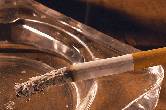- Navigating Your Midlife Crisis: Embracing New Possibilities
- City Raccoons Showing Signs of Domestication
- Mapping the Exposome: Science Broadens Focus to Environmental Disease Triggers
- One Week Less on Social Media Linked to Better Mental Health
- Your Brain Changes in Stages as You Age, Study Finds
- Some Suicide Victims Show No Typical Warning Signs, Study Finds
- ByHeart Formula Faces Lawsuits After Babies Sickened With Botulism
- Switch to Vegan Diet Could Cut Your Greenhouse Gas Emissions in Half
- Regular Bedtime Does Wonders for Blood Pressure
- Dining Alone Could Mean Worse Nutrition for Seniors
Tobacco Tied to Higher Risk of Oral HPV Infection, Study Finds


Tobacco use in any form appears to be linked to an increased risk of infection with oral human papillomavirus type 16 (HPV16), a virus that can cause cancers of the mouth and throat, according to Johns Hopkins University researchers.
The odds of being infected with HPV16, a sexually transmitted disease, rise as tobacco use increases, the researchers said. As few as three cigarettes a day can increase the risk of infection with HPV by almost one-third, according to the study.
How tobacco use might influence HPV16 infection isn’t clear, said lead researcher Dr. Carole Fakhry, an assistant professor of otolaryngology-head and neck surgery at Johns Hopkins University School of Medicine.
“We don’t fully understand oral HPV16,” she said. “People exposed to tobacco could be more likely to become infected after exposure to HPV16 or less likely to get rid of the infection.”
Fakhry cautioned that this study does not prove that tobacco makes it easier to get HPV16, only that the two factors are linked. Since tobacco use is associated with other risky behaviors, it’s possible that people who use tobacco engage in more oral sex, which could increase their odds of being infected with HPV16, Fakhry explained.
She added that smoking, chewing or snorting tobacco doesn’t cause HPV16 infection, but may make it easier to get the infection. Nonsmokers are also at risk for HPV16, especially those exposed to secondhand smoke, she said.
HPV16, which is transmitted through oral sex, is linked to 80 percent of cancers located in the back of the throat, according to the researchers. Over the last 20 years, this type of cancer has increased 225 percent in the United States, the researchers noted.
This year alone, about 37,000 Americans, mostly men, will get mouth or throat cancer, according to the American Cancer Society (ACS). About 7,300 will die from these cancers, according to the ACS.
For the study, Fakhry and her colleagues collected data on nearly 7,000 men and women who took part in the U.S. National Health and Nutrition Examination Survey. Among the participants, there were just over 2,000 tobacco users. More than 80 percent of tobacco users were cigarette smokers, according to the study. Other forms of tobacco use included chew, snuff and pipe smoking, the study found. Sixty-three of the tobacco users were infected with HPV16, the study reported.
The researchers measured blood levels of cotinine, a by-product of tobacco use, and found an amount equal to three cigarettes a day increased the risk of infection 31 percent, according to the study. When they measured urine levels of another tobacco-related marker, NNAL, the risk increased 68 percent when the levels equaled four cigarettes a day, the study found.
“This study highlights the need to understand the effect of tobacco on HPV16 infection over time,” Fakhry said.
The report was published in the Oct. 8 issue of the Journal of the American Medical Association.
Dr. Norman Edelman, a senior consultant for scientific affairs at the American Lung Association, said, “The connection between HPV and tobacco is probably real.”
The question is whether the connection is based in biology or social behavior, he said. Smoking may be a marker of increased oral sex, Edelman said.
“If that is not true, then some of the contents of tobacco promote infection by this sexually transmitted virus, and that’s a very important finding,” he said.
Edelman added that studies have shown that nicotine increases tumor growth and the same could also be the case for viral infection.
“There is a lot of other stuff in tobacco that causes inflammation,” he said. “So it may be that all the other inflammatory components of tobacco allow HPV to attack the tissues of the mouth and grow and stay put.”
This is yet another reason not to smoke, chew tobacco or use snuff, because it’s the same stuff going directly to the mouth, Edelman said. “Oral cancer is very nasty,” he said.
Whatever the reason behind the increased risk of HPV16 infection for people who smoke, a vaccine for HPV — including HPV16 — is available for teens and young adults, according to the U.S. Centers for Disease Control and Prevention (CDC). The vaccine is routinely recommended for 11- and 12-year-old children, but can be given up to age 26 for both males and females, according to the CDC.
More information
For more information on mouth and throat cancer, visit the American Cancer Society.
Source: HealthDay
Copyright © 2025 HealthDay. All rights reserved.










